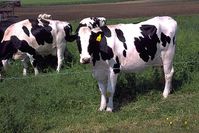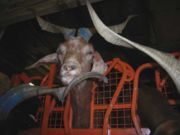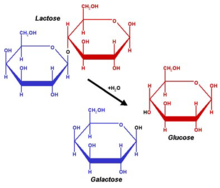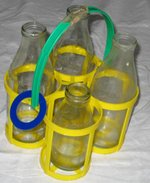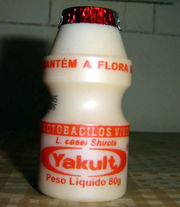Milk
2007 Schools Wikipedia Selection. Related subjects: Drink

Milk is the nutrient fluid produced by the mammary glands of female mammals (including monotremes). The female ability to produce milk is one of the defining characteristics of mammals. It provides the primary source of nutrition for newborns before they are able to digest more diverse foods. The early lactation milk is known as colostrum, and carries the mother's antibodies to the baby. It can reduce the risk of many diseases in both the mother and baby.
The exact components of milk vary by species, but it contains significant amounts of saturated fat, protein and calcium. These amounts are not large in comparison to other foods rich in them, including coconuts, fish, and kale respectively, because milk is predominantly composed of water. Aquatic mammals, such as seals and whales, produce milk that is very rich in fats and other solid nutrients when compared with land mammals' milk.
Humans, like other mammals, can consume mother's milk during their infancy. In many ethnic groups, people lose the ability to digest milk after childhood (that is, they become lactose intolerant), so many traditional cuisines around the world do not feature dairy products. On the other hand, those cultures that do tolerate milk have often exercised great creativity in using the milk of domesticated ruminants, especially cows, but also sheep, goats, yaks, water buffalo, horses and camels. For millenia,s milk has been processed into dairy products such as cream, butter, yogurt, ice cream, and especially the storable and transportable cheese. Industrial science has brought us casein, whey protein, lactose, condensed milk, powdered milk, and many other food-additive and industrial products.
Human milk is fed to infants through breastfeeding, either directly or by expressing the milk to be stored and consumed later.
The term milk is also used for non-animal substitutes such as soy milk, rice milk, almond milk, and coconut milk, and even the regurgitated substance pigeons feed their young, called crop milk, which bears little resemblance to mammalian milk.
History
Animal milk was first used as human food at the beginning of animal domestication. Cow's milk was first used as human food in the Middle East. Goats and sheep were domesticated in the Middle East between 9000 and 8000 BCE. Goats and sheep are ruminants: mammals adapted to survive on a diet of dry grass, a food source otherwise useless to humans, and one that is easily stockpiled. The animals were probably first kept for meat and hides, but dairying proved to be a more efficient way of turning uncultivated grasslands into sustenance: the food value of an animal killed for meat can be matched by perhaps one year's worth of milk from the same animal, which will keep producing milk — in convenient daily portions — for years (McGee 8–10).
Around 7000 BCE, cattle were being herded in parts of Turkey. There is evidence of milk consumption in the British Isles during the Neolithic period. The use of cheese and butter spread in Europe, parts of Asia and parts of Africa. Domestic cows, which previously existed throughout much of Eurasia, were then introduced to the colonies of Europe during the Age of exploration.
In the Western world today, cow's milk is produced on an industrial scale. It is by far the most commonly consumed form of milk. Commercial dairy farming using automated milking equipment produces the vast majority of milk in developed countries. Types of cattle such as the Holstein have been specially bred for increased milk production. According to McGee, 90% of the dairy cows in the United States and 85% in Great Britain are Holsteins (McGee 12). Other milk cows in the United States include Ayrshire, Brown Swiss, Guernsey, Jersey, and Milking Shorthorn. The largest producers of dairy products and milk today are India followed by the USA and New Zealand.
Insert non-formatted text hereInsert non-formatted text here==Other milk animals==
In addition to cows, the following animals provide milk for dairy products:
- Sheep (the ewe)
- Goats (the nanny)
- Horses (the mare)
- Donkeys
- Camels (including the South American camelids)
- Yaks
- Water buffalo
- Reindeer
In Russia and Sweden, small moose dairies also exist. Donkey and horse milk have the lowest fat content, while the milk of seals contains more than 50% fat.
Whale's milk, not used for human consumption, is one of the highest-fat milks. It contains, on average, 10.9% protein, 42.3% fat, and 2.0% lactose, and supplies 443 kcal of energy per 100 grams.
Human milk is not produced or distributed industrially or commercially; however, milk banks exist that allow for the collection of donated human milk and its redistribution to infants who may benefit from human milk for various reasons (premature neonates, babies with allergies or metabolic diseases, etc.).
Physical and chemical structure
Milk is an emulsion of butterfat globules within a water-based fluid. Each fat globule is surrounded by a membrane consisting of phospholipids and proteins; these emulsifiers keep the individual globules from joining together into noticeable grains of butterfat and also protect the globules from the fat-digesting activity of enzymes found in the fluid portion of the milk. In unhomogenized cow's milk, the fat globules average about four micrometers across. The fat-soluble vitamins A, D, E, and K are found within the milkfat portion of the milk (McGee 18).
The largest structures in the fluid portion of the milk are casein protein micelles: aggregates of several thousand protein molecules, bonded with the help of nanometer-scale particles of calcium phosphate. Each micelle is roughtly spherical and about a tenth of a micrometer across. There are four different types of casein proteins, and collectively they make up around 80 percent of the protein in milk, by weight. Most of the casein proteins are bound into the micelles. There are several competing theories regarding the precise structure of the micelles, but they share one important feature: the outermost layer consists of strands of one type of protein, kappa-casein, reaching out from the body of the micelle into the surrounding fluid. These Kappa-casein molecules all have a negative electrical charge and therefore repel each other, keeping the micelles separated under normal conditions and in a stable colloidal suspension in the water-based surrounding fluid (McGee 19–20).
Both the fat globules and the smaller casein micelles, which are just large enough to deflect light, contribute to the opaque white colour of milk. The fat globules contain some yellow-orange carotene, enough in some breeds — Guernsey and Jersey cows, for instance — to impart a golden or "creamy" hue to a glass of milk. The riboflavin in the whey portion of milk has a greenish colour, which can sometimes be discerned in skim milk or whey products (McGee 17). Fat-free skim milk has only the casein micelles to scatter light, and they tend to scatter shorter-wavelength blue light more than they do red, giving skim milk a bluish tint.
Milk contains dozens of other types of proteins besides the caseins. They are more water-soluble than the caseins and do not form larger structures. Because these proteins remain suspended in the whey left behind when the caseins coagulate into curds, they are collectively known as whey proteins. Whey proteins make up around twenty percent of the protein in milk, by weight. Lactoglobulin is the most common whey protein by a large margin (McGee 20–21).
The carbohydrate lactose gives milk its sweet taste and contributes about 40% of whole cow milk's calories. Lactose is a composite of two simple sugars, glucose and galactose. In nature, lactose is found only in milk and a small number of plants (McGee 17). Other components found in raw cow milk are living white blood cells, mammary-gland cells, various bacteria, and a large number of active enzymes (McGee 16).
Processing
In North America a dairy facility processes milk and products obtained from milk (dairy products), such as cream, butter, and cheese. Most dairies are local companies, as opposed to large or nationwide companies found in the southern hemisphere.
Pasteurization and raw milk
Pasteurization kills many harmful microorganisms by heating the milk for a short time and then cooling it for storage and transportation. Pasteurized milk is still perishable and must be stored cold by both suppliers and consumers. Dairies print expiration dates on each container, after which stores will remove any unsold milk from their shelves. In many countries it is illegal to sell milk that is not pasteurized.
Milk may also be further heated to extend its shelf life through ultra-high temperature treatment ( UHT), which allows it to be stored unrefrigerated, or even longer lasting sterilization.
Those preferring raw milk argue that the pasteurization process also kills beneficial microorganisms and important nutritional constituents. The resulting pasteurized product is said to contribute to its own indigestability, be less nutritious, and turn rancid (as opposed to sour) with age. However, unpasteurized milk can harbour harmful disease-causing bacteria such as tuberculosis, salmonella, diphtheria, polio, and escherichia coli.
Creaming and homogenization
Upon standing for 12 to 24 hours, fresh milk has a tendency to separate into a high-fat cream layer on top of a larger, low-fat milk layer. The cream is often sold as a separate product with its own uses; today the separation of the cream from the milk is usually accomplished rapidly in centrifugal cream separators. The fat globules rise to the top of a container of milk because fat is less dense than water. The smaller the globules, the more other molecular-level forces prevent this from happening. In fact, the cream rises in cow milk much quicker than a simple model would predict: rather than isolated globules, the fat in the milk tends to form into clusters containing about a million globules, held together by a number of minor whey proteins (McGee 19). These clusters rise faster than individual globules can. The fat globules in milk from goats, sheep, and water buffalo do not form clusters as readily and are smaller to begin with; cream is very slow to separate from these milks (McGee 19).
Milk is often homogenized, a treatment which prevents a cream layer from separating out of the milk. The milk is pumped at high pressures through very narrow tubes, breaking up the fat globules through turbulence and cavitation. A greater number of smaller particles possess more total surface area than a smaller number of larger ones, and the original fat globule membranes cannot completely cover them. Casein micelles are attracted to the newly-exposed fat surfaces; nearly one-third of the micelles in the milk end up participating in this new membrane structure. The casein weighs down the globules and interferes with the clustering that accelerated separation. The exposed fat globules are briefly vulnerable to certain enzymes present in milk, which could break down the fats and produce rancid flavors. To prevent this, the enzymes are inactivated by pasteurizing the milk immediately before or during homogenization. Homogenized milk tastes blander but feels creamier in the mouth than unhomogenized; it is whiter and more resistant to developing off flavours (McGee 23). Creamline, or cream-top, milk is unhomogenized; it may or may not have been pasteurized.
Additives
Milk, sold commercially in countries where the cattle (and often the people) live indoors, commonly has vitamin D added to it to make up for lack of exposure to UVB radiation. Milk often has flavoring added to it for better taste or as a means of improving sales. Chocolate flavored milk has been sold for many years and has been followed more recently by such other flavours as strawberry and banana.
South Australia has the highest consumption of flavoured milk per person, where Farmers Union Iced Coffee outsells Coca-Cola, a success shared only by Inca Kola in Peru and Irn-Bru in Scotland.
Nutrition and health
The composition of milk differs widely between species. Factors such as the type of protein; the proportion of protein, fat, and sugar; the levels of various vitamins and minerals; and the size of the butterfat globules and the strength of the curd are among those than can vary. Introduction to Dairy Science and Technology, webpage of University of Guelph For example:
- Human milk contains, on average, 1.1% protein, 4.2% fat, 7.0% lactose (a sugar), and supplies 72 kcal of energy per 100 grams.
- Cow's milk contains, on average, 3.4% protein, 3.6% fat, and 4.6% lactose, and supplies 66 kcal of energy per 100 grams. See also Nutritional benefits further on.
Nutritional benefits
| Cow milk (whole) Nutritional value per 100 g |
|||||||||||||||||||||||||||||
|---|---|---|---|---|---|---|---|---|---|---|---|---|---|---|---|---|---|---|---|---|---|---|---|---|---|---|---|---|---|
| Energy 60 kcal 250 kJ | |||||||||||||||||||||||||||||
|
|||||||||||||||||||||||||||||
| 100 g corresponds to 103 ml. Percentages are relative to US recommendations for adults. Source: USDA Nutrient database |
|||||||||||||||||||||||||||||
Milk began containing differing amounts of fat during the 1950's. A serving (1 cup or 250 ml) of 2%-fat milk contains 285 mg of calcium, which represents 22% to 29% of the daily recommended intake (DRI) of calcium for an adult. Depending on the age, 8 grams of protein, and a number of other nutrients (either naturally or through fortification):
- Vitamins D and K are essential for bone health.
- Iodine is a mineral essential for thyroid function.
- Vitamin B12 and riboflavin are necessary for cardiovascular health and energy production.
- Biotin and pantothenic acid are B vitamins important for energy production.
- Vitamin A is critical for immune function.
- Potassium and magnesium are for cardiovascular health.
- Selenium is a cancer-preventive trace mineral.
- Thiamine is a B-vitamin important for cognitive function, especially memory
- Conjugated linoleic acid is a beneficial fatty acid that inhibits several types of cancer in mice, it has been shown to kill human skin cancer, colorectal cancer and breast cancer cells in vitro studies, and may help lower cholesterol and prevent atherosclerosis; only available in milk from grass-fed cows.
Studies show possible links between low-fat milk consumption and reduced risk of arterial hypertension, coronary heart disease, and obesity. Overweight individuals who drink milk may benefit from decreased risk of insulin resistance and type 2 diabetes.
Nutritional/physiological detriments
Consumption of cow's milk and its byproducts (hereafter referred to as "milk") are reported as 'unhealthy' primarily due to their high saturated fat and cholesterol content. The following additional issues are often cited as warranting consideration:
- Lactose intolerance, discussed below.
- Milk that has not received a fat content reduction is rich in saturated fat and cholesterol, which numerous sources have suggested as contributing to an increased risk of atherosclerosis and coronary heart disease. Low-fat and non-fat forms of milk may mitigate this risk.
- Cow milk allergy (CMA) is as an immunologically mediated adverse reaction to one or more cow's milk proteins. Rarely it is severe enough to cause death.
- Milk contains varying levels of white blood cells, depending upon the health of the source animals; controversy surrounds whether these are simply somatic cells or, in an alternate form, pus . In the United States, one to seven drops of these cells are in every eight-ounce glass of milk, varying by state, according to guidelines set up by the Food and Drug Administration and statistics reported by the dairy industry . Only one state out of all fifty, Hawaii, has a cell count lower than the dairy industry's recommendations; seventeen states produce milk that would be illegal to sell based on somatic cell limits in Europe.
- Since November 1993, with FDA approval, Monsanto has been selling recombinant bovine somatotropin (rbST)--or rBGH--to dairy farmers. Bovine growth hormone is administered to cattle in order to increase their milk production, though the hormone also naturally fosters liver production of insulin-like growth factor 1 (IGF1). The deposit, thereof, in the milk of rBGH-affected cattle has been the source of concern, however all milk contains IGF1. The IGF1 in milk from rBGH-affected cattle does not vary from the range normally found in a non-supplemented cow. Elevated levels of IGF1 in human blood has been linked to increased rates of breast, colon, and prostate cancer by stimulating their growth , though this has not been linked to milk consumption. The EU has recommended against Monsanto milk. In addition, the cows frequently contract an udder infection known as mastitis, partly responsible for the aforementioned prevalence of blood cells in dairy products . Milk from rBGH-affected cattle is banned in Canada, Australia, New Zealand, and Japan due to the mastitis problems. On June 9, 2006 the largest milk processor in the world and the two largest supermarkets in the United States-- Dean Foods, Wal-Mart, and Kroger--announced that they are "on a nationwide search for rBGH-free milk ."
- Several sources suggest a correlation between high calcium intake (2000 mg per day, or twice the US recommended daily allowance, equivalent to six or more glasses of milk per day) and prostate cancer . A large study specifically implicates dairy . A review published by the World Cancer Research Fund and the American Institute for Cancer Research states that at least eleven human population studies have linked dairy product consumption and prostate cancer.
Lactose intolerance
Lactose is a simple sugar that is present in all milk of the species of origin, and is digested with the help of the enzyme lactase. The production of this enzyme declines significantly after weaning in all mammals, including human beings. Lactose intolerance is the condition in which lactase is not produced in adulthood. With lactose intolerance, the result of consuming too much lactose is excess gas production and often diarrhea. Lactose-intolerant adults can drink about a cup (250 ml or 8 oz) of milk per day without severe symptoms.
Most adults in the world are lactose-intolerant (McGee 14: "lactose tolerant adults are a distinct minority on the planet"). Lactose-intolerant adults stop producing significant amounts of lactase sometime between the ages of two and five. A relatively recent genetic change caused some populations (McGee 14: "several thousand years ago"), including many Northern Europeans, to continue producing lactase into adulthood.
Distribution
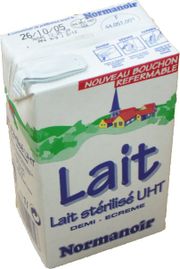
Because milk spoils so easily, it should, ideally, be distributed as quickly as possible. In many countries milk used to be delivered to households daily, but economic pressure has made milk delivery much less popular, and in many areas daily delivery is no longer available. People buy it chilled at grocery or convenience stores or similar retail outlets. Prior to the widespread use of plastics, milk was often distributed to consumers in glass bottles, and before that in bulk that was ladled into the customer's container. In the UK, milk can be delivered daily by a milkman who travels his local milk round (route) using a battery-powered milk float, although this is becoming less popular as a result of supermarkets selling milk at lower prices. In New Zealand, milk is no longer distributed in glass bottles. In India, milk is sold in plastic sachet.
In the United States bottles were replaced with milk cartons, which are tall boxes with a square cross-section and a peaked top that can folded outward upon opening to form a spout. Now milk is increasingly sold in plastic bottles. First the gallon and half-gallon sizes were sold in plastic jugs while the smaller sizes were sold in milk cartons. Recently milk has been sold in smaller resealable bottles made to fit in automobile cup holders.
The half-pint milk carton is the traditional unit as a component of school lunches. In the US, pictures of missing children were printed on the larger milk cartons as a public service until it was determined that this was disturbing to children.
Milk preserved by the UHT process is sold in cartons often called a "brick" that lack the peak of the traditional milk carton. Milk preserved in this fashion does not need to be refrigerated before opening and has a longer shelf life than milk in ordinary packaging.
Glass milk containers are rare these days. Most people purchase milk in plastic jugs or bags or in waxed-paper cartons, such as those made by Tetra Pak. Ultraviolet light from fluorescent lighting can destroy some of the proteins in milk so many companies that once distributed milk in transparent or highly translucent containers are now using thicker materials that block the harmful rays. Many people feel that such "UV protected" milk tastes better.
Milk comes in a variety of containers with local variants:
- United States: Commonly sold in gallon, half-gallon and quart containers ( U.S. customary units) of rigid plastic or, occasionally for sizes less than a gallon, waxed cardboard. The US single-serving size is usually the half-pint (about 240 ml).
- Canada: 1.33 litre plastic bags (sold as 4 litres in 3 bags) are widely available in some areas (especially Ontario and Québec), although the 4 litre plastic jug has supplanted them in western Canada. Other common packaging sizes are 2 litre, 1 litre, 500 millilitre, and 250 millilitre cartons, as well as 4 litre, 1 litre, 250 mL Tetra Pak cartons and 500 millilitre plastic jugs.
- Parts of Europe: Sizes of 500 millilitres, 1 litre (the most common), 2 litres and 3 litres are commonplace.
- United Kingdom: Most stores stock Imperial sizes: 1 pint (568 mL), 2 pints (1.136 L), 4 pints (2.273 L), 6 pints (3.408 L) or, rarely, a combination including both metric and imperial sizes. Glass milk bottles delivered to the doorstep by the milkman are pint-sized and are returned empty by the householder for repeated recycling. Milk is also sold at supermarkets in either Tetra-Pak cartons or plastic bottles, also measured in pints. Milk continues to be legally sold by the Imperial pint in the UK under EU regulations (a distinction only shared with beer).
- Australia and New Zealand: Distributed in a variety of sizes, most commonly in Tetra Pak cartons for up to 1 litres, and plastic screw-top bottles beyond that with the following volumes; 1.1L, 2L, and 3L. 1 litre Bags are starting to appear in supermarkets, but have not yet proved popular. Most UHT-milk is packed in 1 litre paper containers with a sealed plastic spout.
- South Africa: Commonly sold in 1 litre bags. The bag is then placed in a plastic jug and the corner cut off before the milk is poured.
- China: Sweetened milk is a drink popular with students of all ages and is often sold in small plastic bags complete with straw. Adults not wishing to drink at a banquet often drink milk served from cartons or milk tea.
- India: Milk is often delivered daily to most urban homes in plastic bags. It is still customary to serve the milk boiled, despite pasteurization. Flavored milk is sold in most convenience stores in waxed cardboard containers.Convenience stores also sell many varieties of milk (such as flavored and ultra-pasteurized) in different sizes, usually in Tetra-Pak cartons.
- Japan: Commonly sold in 1 litre waxed cardboard boxes. In most city centers there is also home delivery of milk in glass jugs. As seen in China, sweetened milk drinks are very popular to see in vending machines.
- Brazil: Used to be sold in cooled or frozen 1 litre bags, just like for South Africa. Nowadays the most common form is 1 litre Tetra-Pak cartons containing skimmed, semi-skimmed or whole milk.
- Hong Kong - milk is sold in glass bottles (220 mL), cartons (236 mL and 1L), plastic jugs (2 litres) and Tetra Pak cartons (250 mL).
Condensed milk is distributed in metal cans, 250 and 125 ml paper containers and 100 and 200 ml squeeze tubes, and powdered milk (skim and whole) is distributed in boxes or bags.
- South Korea: sold in cartons (180mL, 200mL, 500mL 900mL, 1L, 1.8L, 2.3L), plastic jugs (100Ml and 1.8L), Tetra Pak cartons (180mL and 200mL) and plastic bags (100mL).
Varieties and brands
Cow's milk is generally available in several varieties. In some countries these are:
- Full cream (or "whole" in US, "homo milk" in Canada & some US dairies, about 3.25% fat)
- Semi-skimmed ("reduced fat" or "low fat", about 1.5-1.8% fat)
- Skimmed (about 0.1% fat)
Milk in the U.S. and Canada is sold as:
- Whole varieties
- 2% (reduced fat)
- 1% (low fat)
- <0.5% (very low fat)
- Skim (nearly no fat)
In Canada "whole" milk refers to creamline (unhomogenized) milk. "Homogenized" milk refers to milk which is 3.25% butterfat. Generally all store-bought milk in Canada has been homogenized. Yet, the term is also used as a name to describe butterfat content for a specific variety of milk. Modern commercial dairy processing techniques involve first removing all of the butterfat, and then adding back the appropriate amount depending on which product is being produced on that particular line.
In Britain, it is possible to get Channel Island milk, which is 5.5% fat.
In the United States, skim milk is also known as "fat free" milk, due to USDA regulations stating that any food with less than ½ gram of fat per serving can be labeled "fat free".
Full cream, or whole milk, has the full milk fat content (about 3-4% if Friesian- or Holstein-breed are the source). For skimmed or semi-skimmed milk, all of the fat content is removed and then some (in the case of semi-skimmed milk) is returned. The best-selling variety of milk is semi-skimmed; in some countries full-cream (whole) milk is generally seen as less healthy and skimmed milk is often thought to lack taste. Whole milk is recommended to provide sufficient fat for developing toddlers who have graduated from breast milk or infant formula.
In the United States and Canada, a blended mixture of half cream and half milk is often sold in small quantities and is called half-and-half. Half-and-half is used for creaming coffee and similar uses.
Spoilage
When raw milk is left standing for a while, it turns " sour". This is the result of fermentation: lactic acid bacteria turning the sugar inside the milk into lactic acid. This fermentation process is exploited in the production of various dairy products such as cheese and yogurt. There are four noted periods of milk decay:
- Rancid (also called "on the turn". Milk is still consumable at this stage)
- Curdling (separation of curd and whey will occur but may still be consumable)
- Coagulation (beyond use. A period of aromatic decay sets in accompanied by mould)
- Dry (beyond use. The milk has dehydrated and become hard and chalky)
Pasteurized cow's milk, on the other hand, spoils in a way that makes it unsuitable for consumption. This causes it to assume an unpleasant odour and pose a high danger of food poisoning if ingested. In raw milk, the naturally-occurring lactic acid bacteria, under suitable conditions, quickly produce large amounts of lactic acid. The ensuing acidity in turn prevents other germs from growing, or slows their growth significantly. Through pasteurization, however, these lactic acid bacteria are mostly destroyed, which means that other germs can grow unfettered and thus cause decomposition.
In order to prevent spoilage, milk can be kept refrigerated and stored between 1 and 4 degrees Celsius in bulk tanks. Most milk is pasteurized by heating briefly and then refrigerated to allow transport from factory farms to local markets. The spoilage of milk can be forestalled by using ultra-high temperature ( UHT) treatment; milk so treated can be stored unrefrigerated for several months until opened. Sterilized milk, which is heated for a much longer period of time, will last even longer, but also lose more nutrients and assume a still different taste. Condensed milk, made by removing most of the water, can be stored in cans for many years, unrefrigerated, as can evaporated milk. The most durable form of milk is milk powder, which is produced from milk by removing almost all water.
Milk in language and culture
The importance of milk in human culture is attested to by the numerous expressions embedded in our languages, for example "the milk of human kindness", and the ways we have used it to name the visible world, for example the Milky Way.
Milk is drunk as an accompaniment to meals in North America, whereas Europeans do not habitually do so after childhood.
In African and Asian developing nations, butter is traditionally made from sour milk rather than cream. It can take several hours of churning to produce workable butter grains from fermented milk.
